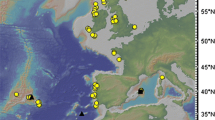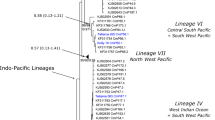Abstract
Pseudobulweria is one of the least known and most endangered of all seabird genera. It comprises six taxa, of which two are extinct, three are critically endangered and one is near threatened. Phylogenetic relationships between these taxa and position of the genus in the Order Procellariiformes have never been studied, and the taxonomic status of several taxa remains unsettled. Conservation management of Pseudobulweria taxa will be enhanced if these uncertainties are resolved. We used a multilocus gene tree approach with two mitochondrial DNA markers (cytochrome oxidase subunit 1 and cytochrome b gene) and one nuclear intron (β Fibrinogen intron 7) to investigate phylogenetic relationships within the genus using sequences from all taxa. We combined gene trees to estimate a phylogeny of the genus using a multispecies coalescent methodology. We confirmed the link between Pseudobulweria and a clade comprising Puffinus and Bulweria genera. The Fiji petrel’s status, as belonging to the genus, is confirmed, as is the specific status of newly rediscovered Beck’s petrel. Maintenance of the two sub-species of Tahiti petrel as currently described is not supported. Discovering the breeding grounds of all taxa is the key for their conservation, which is vital to both the marine and fragile insular tropical ecosystems where Pseudobulweria are apical predators.





Similar content being viewed by others
References
Attié C, Stahl J-C, Bretagnolle V (1997) New data on the endangered mascarene petrel Pseudobulweria aterrima: a third twentieth century specimen and distribution. Colon Waterbirds 20:406–412
Bandlet HJ, Forster P, Röhl A (1999) Median-joining networks for inferring intraspecific phylogenies. Mol Biol Evol 16:37–48
Bowen BW (1999) Preserving genes, species or ecosystems? Healing the fractured foundations of conservation policy. Mol Ecol 8:S5–S10
Bretagnolle V (1993) Adaptive significance of seabird colouration: the case of Procellariiforms. Am Nat 142(1):141–173
Bretagnolle V (1995) Systematics of the soft-plumaged petrel Pterodroma mollis complex: new insight from vocalizations. Ibis 137:207–218
Bretagnolle V, Attié C, Pasquet E (1998) Cytochrome b evidence for validity and phylogenetic relationships of Pseudobulweria and Bulweria. Auk 115(1):188–195
Brooke M (2004) Albatrosses and petrels across the world. Oxford University Press, New York
Buchanan GM, Butchart SHM, Dutson G, Pilgrim JD, Steininger MK, Bishop KD, Mayaux P (2008) Using remote sensing to inform conservation status assessment: estimates of recent deforestation rates on New Britain and the impacts upon endemic birds. Biol Conserv 141:56–66
Carstens BC, Knowles LL (2007) Estimating species phylogeny from gene tree probabilities despite incomplete lineage sorting: an example from Melanoplus grasshoppers. Syst Biol 56:400–411
Collar NJ, Andrew P (1988) Birds to watch. ICBP technical publication No. 8. Cambridge, UK
Degnan JH, Rosenberg NA (2009) Gene tree discordance, phylogenetic inference and the multispecies coalescent. Trends Ecol Evol 24(6):332–340
Del Hoyo J, Elliott A, Sargatal J (1992) Handbook of the birds of the world, vol 1. Lynx Edicions, Barcelona
Drummond AJ, Rambaut A (2007) BEAST: Bayesian evolutionary analysis by sampling trees. BMC Evol Biol 7:214
Drummond SP, Wilson KA, Meijaard E, Watts M, Dennis R, Christy L, Posingham HP (2009) Influence of a threatened-species focus on conservation planning. Conserv Biol 24(2):441–449
Ebersberger I, Galgoszy P, Taudien S, Taenzer S, Platzer M, von Haeseler A (2007) Mapping human genetic ancestry. Mol Biol Evol 24(10):2266–2276
Farrier D, Whelan R, Mooney C (2007) Threatened species listing as a trigger for conservation action. Environ Sci Policy 10(3):219–229
Friesen VL, Burg TM, McCoy KD (2007) Mechanisms of population differentiation in seabirds. Mol Ecol 16:1765–1785
Guindon S, Gascuel O (2003) A simple, fast and accurate method to estimate large phylogenies by maximum-likelihood. Syst Biol 52:696–704
Haq BU, Hardenbol J, Vail PR (1987) Chronology of fluctuating sea levels since the triassic. Science 235:1156–1167
Hebert PDN, Stoeckle MY, Zemlak TS, Francis CM (2004) Identification of birds through DNA barcodes. PLOS Biol 2(10):e312
Heled J, Drummond AJ (2010) Bayesian inference of species trees from multilocus data. Mol Biol Evol 27(3):570–580
Huelsenbeck JP, Ronquist F (2001) MRBayes: Bayesian inference of phylogeny. Bioinformatics 17:754–755
Imber MJ (1985) Origins, phylogeny and taxonomy of the gadfly petrels Pterodroma spp. Ibis 127:197–229
IUCN (2010) IUCN red list of threatened species. Version 2010.2. www.iucnredlist.org. Downloaded on 26 July 2010
Janis CM (1993) Tertiary mammal evolution in the context of changing climates, vegetation and tectonic events. Annu Rev Ecol Syst 24:467–500
Jennings WB, Edwards SV (2005) Speciational history of Australian grassfinches (Poephila) inferred from thirty gene trees. Evolution 59:2033–2047
Jesus J, Menezes D, Gomes S, Oliveira P, Nogales M, Brehm A (2009) Phylogenetic relationships of gadfly petrels Pterodroma spp. from the Northeastern Atlantic Ocean: molecular evidence for specific status of Bugio and Cape Verde petrels and implications for conservation. Bird Conserv Int 19:1–16
Johnsen A, Rindal E, Ericson PGP, Zuccon D, Kerr KCR, Stoeckle MY, Lifjeld JT (2010) DNA barcoding of Scandinavian birds reveals divergent lineages in trans-Atlantic species. J Ornithol. doi:10.1007/s10336-009-0490-3
Jouanin C, Mougin JL (1979) Order Procellariiformes. In: Mayr E, Cottrell GW (eds) Checklist of birds of the world, vol 1, 2nd edn. Museum of Comparative Zoology, Cambridge, pp 48–121
Kennedy M, Page RDM (2002) Seabird supertrees: combining partial estimates of Procellariiform phylogeny. Auk 119(1):88–108
Kerr KCR, Stoeckle MY, Dove CJ, Weigt LA, Francis CM, Hebert PDN (2007) Comprehensive DNA barcode coverage of North American birds. Mol Ecol Notes 7:535–543
Kubatko LS, Degnan JH (2007) Inconsistency of phylogenetic estimates from concatenated data under coalescence. Syst Biol 56:17–24
Le Corre M, Ghestemme T, Salamolard M, Couzi F-X (2003) Rescue of the mascarene petrel, a critically endangered seabird of Reunion Island, Indian Ocean. Condor 105:387–391
LeCorre M, Ollivier A, Ribes S, Jouventin P (2002) Light-induced mortality of petrels: a 4 year study from Reunion Island (Indian Ocean). Biol Conserv 105:93–102
Lewis AR et al (2008) Mid-miocene cooling and the extinction of tundra in continental Antarctica. Proc Natl Acad Sci USA 105(31):10676–10680
Librado P, Rozas J (2009) DnaSP v5: a software for comprehensive analysis of DNA polymorphism data. Bioinformatics 25(11):1451–1452
Liu L, Yu L, Kubatko L, Pearl DK, Edwards SV (2009a) Coalescent methods for estimating phylogenetic trees. Mol Phylogenetic Evol 53(1):320–328
Liu L, Yu L, Pearl DK, Edwards SV (2009b) Estimating species phylogenies using coalescence times among sequences. Syst Biol 58:468–477
Mathews GM (1936) A note on the black Fiji petrel. Ibis 6:309
Mayr G (2009) Notes on the osteology and phylogenetic affinities of the oligocene Diomedeoididae (Aves, Procellariiformes). Fossil Rec 12(2):133–140
Miller KG, Fairbanks RG (1983) Evidence for oligocene—middle miocene abyssal circulation changes in the western North Atlantic. Nature 306(5940):250–253
Mundy NI (2005) A window on the genetics of evolution: MC1R and plumage colouration in birds. Proc R Soc B 272:1633–1640
Murphy RC (1928) Birds collected during the Whitney South Sea Expedition. IV. American Museum Novitates 322
Nichols R (2001) Gene trees and species trees are not the same. Trends Ecol Evol 16(7):358–364
Nunn GB, Stanley SE (1998) Body size effects and rates of cytochrome b evolution in tube-nosed seabirds. Mol Biol Evol 15:1360–1371
O’Meara BC (2010) New heuristic methods for joint species delimitation and species tree inference. Syst Biol 59(1):59–73
Olson SL (1975) Remarks on the generic characters of Bulweria. Ibis 117:111–113
Pamilo P, Nei M (1988) Relationships between gene trees and species trees. Mol Biol Evol 5(5):568–583
Penhallurick J, Wink M (2004) Analysis of the taxonomy and nomenclature of the Procellariiformes based on complete nucleotide sequences of the mitochondrial cytochrome b gene. Emu 104:125–147
Pereira SL, Baker AJ (2006) A mitogenomic timescale for birds detects variable phylogenetic rates of molecular evolution and refutes the standard molecular clock. Mol Biol Evol 23(9):1731–1740
Posada D (2008) jModelTest: phylogenetic model averaging. Mol Biol Evol 25(7):1253–1256
Posigham HP, Andelman SJ, Burgman MA, Medellin RA, Master LL, Keith DA (2002) Limits to the use of threatened species lists. Trends Ecol Evol 17(11):503–507
Priddel D, Carlile N, Moce K, Watling D (2008) A review of records and recovery actions for the critically endangered Fiji petrel Pseudobulweria macgillivrayi. Bird Conserv Int 18:381–393
Prychitko TM, Moore WS (1997) The utility of DNA sequences of an intron from the β-fibrinogen gene in phylogenetic analysis of woodpeckers (Aves: Picidae). Mol Phylogenetic Evol 8:193–204
Rheindt FE, Austin JJ (2005) Major analytical and conceptual shortcomings in a recent taxonomic revision of the Procellariiformes—a reply to Penhallurick and Wink (2004). Emu 105:181–186
Ronquist F, Huelsenbeck JP (2003) MrBayes 3: Bayesian phylogenetic inference under mixed models. Bioinformatics 19(12):1572–1574
Ronquist F, Huelsenbeck JP, Van der Mark P (2005) MrBayes 3.1 Manual. http://mrbayes.csit.fsu.edu/. Accessed March 2010
Shevenell AE, Kennett JP, Lea DW (2004) Middle miocene Southern ocean cooling and Antarctic cryosphere expansion. Science 305:1766–1770
Shirihai H (2008) Rediscovery of beck’s petrel Pseudobulweria becki, and other observations of tubenoses from the bismarck archipelago, papua new Guinea. Bull Br Ornithol Club 128:3–16
Shirihai H, Pym T, Kretzschmar J, Moce K, Taukei A, Watling D (2009) First observation of Fiji petrel Pseudobulweria macgillivrayi at sea: off Gau island, Fiji, in May 2009. Bull Br Ornithol Club 129:129–148
Sibley CG, Monroe BL (1990) Distribution and taxonomy of birds of the world. Yale University Press, New Haven
Sullivan J, Joyce P (2005) Model selection in phylogenetics. Annu Rev Ecol Evol Syst 36:445–466
Syring J, Farrell K, Businsky R, Cronn R, Liston A (2007) Widespread genealogical non-monophyly in species of Pinus subgenus Strobus. Syst Biol 56:163–181
Tamura K, Dudley J, Nei M, Kumar S (2007) MEGA4: molecular evolutionary genetics analysis (MEGA) software version 4.0. Mol Biol Evol 24(8):1596–1599
Thompson JD, Higgins DG, Gibson TJ (1994) CLUSTAL W: improving the sensitivity of progressive multiple sequence alignment through sequence weighting, position-specific gap penalties and weight matrix choice. Nucleic Acids Res 22(22):4673–4680
Villard P, Dano S, Bretagnolle V (2006) First data on the breeding biology of the Tahiti petrel Pseudobulweria rostrata. Ibis 148:285–291
Warham J (1990) The petrels: their ecology and breeding systems. Academic Press, London
Warheit KI (1992) A review of the fossil seabirds from the tertiary of the North Pacific: plate tectonics, paleoceanography, and faunal change. Paleobiology 18(4):401–424
Warheit KI (2002) The seabird fossil record and the role of paleontology in understanding seabird community structure. In: Schreiber, Burger (eds) Biology of marine birds. CRC Press, Boca Raton
Weir JT, Schluter D (2008) Calibrating the avian molecular clock. Mol Ecol 17:2321–2328
Worthy TH, Tennyson AJD (2004). Avifaunal assemblages from the Nenega-Iti and Onemea sites. In: Conte E, Vinton Kirch P (eds) Archaeological Investigations in the Mangareva Islands (Gambier Archipelago), French Polynesia, Chapter 6. Archaeological Research Facility Contributions No. 62. University of California, Berkeley
Yang Z (1994) Maximum likelihood phylogenetic estimation from DNA sequences with variable rates over sites: approximate methods. J Mol Evol 39(3):306–314
Yang Z, Rannala B (2010) Bayesian species delimitations using multilocus sequence data. PNAS 107(20):9264–9269
Acknowledgments
This study was supported by the “Consortium National de Recherche en Génomique”, and the “Service de Systématique Moléculaire” of the Muséum National d’Histoire Naturelle (CNRS UMS 2700). It is part of the agreement No. 2005/67 between the Genoscope and the Muséum National d’Histoire Naturelle on the project “Macrophylogeny of life” directed by Guillaume Lecointre. We are deeply indebted to Joel Cracraft, Curator, Paul Sweet, Collection Manager, and Margaret Hart at the American Museum of Natural History (AMNH) for giving us access to the collections and providing samples from Pseudobulweria becki type specimens. BG also acknowledges receipt of a Collection Study Grant from the AMNH. We thank Alice Cibois for providing us samples from P. rostrata rostrata from Marquesas. Many thanks also to T. Steeves and P. Pelser for useful comments that improved an early draft of the manuscript and to two anonymous referees whose comments greatly improved the manuscript.
Author information
Authors and Affiliations
Corresponding author
Rights and permissions
About this article
Cite this article
Gangloff, B., Shirihai, H., Watling, D. et al. The complete phylogeny of Pseudobulweria, the most endangered seabird genus: systematics, species status and conservation implications. Conserv Genet 13, 39–52 (2012). https://doi.org/10.1007/s10592-011-0261-6
Received:
Accepted:
Published:
Issue Date:
DOI: https://doi.org/10.1007/s10592-011-0261-6




